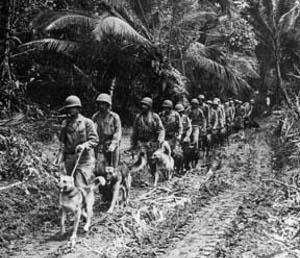K-9Dogs of war: the role of canines in the Second World War
A new book examines how dogs were used by the U.S. and Japanese militaries during the Second World War; the book goes beyond the battlefield duties of these four-legged soldiers and captures how dogs like New York City’s “Skippy” and Tokyo’s “Aren” mobilized their people to their nations’ causes

USMC K-9 patrol, Bougainville in December, 1943 // Source: olive-drab.com
Seventy years since the United States entered the Second World War after the Japanese attack on Pearl Harbor, a BYU historian has a new look at an often overlooked breed of soldier.
In his book Empire of Dogs: Canines, Japan, and the Making of the Modern Imperial World (Cornell University Press), Professor Aaron Skabelund goes beyond the battlefield duties of these four-legged soldiers and captures how dogs like New York City’s “Skippy” and Tokyo’s “Aren” mobilized their people to their nations’ causes.
“It may be surprising to some that dogs were used in a similar manner by all combatant countries, both Axis and Allies,” Skabelund said. “They ran messages, carried ammunition, guarded prisoners and flushed out enemy soldiers that remained in the aftermath of certain battles.” A Brigham Young University release notes that in America, an organization called Dogs for Defense encouraged people to enlist their dogs in military service.
The recruitment included school assemblies where the military could appeal directly to children. At Public School No. 66 in New York City, one 10-year-old girl enlisted Skippy, a shepherd-collie mix, while the rest of the student body sang The K9 Corps march.
For families that owned dogs too small for military specifications, Dogs for Defense provided an alternative: Sponsor another dog’s training in your pet’s name.
“In exchange for a financial donation, their dog was awarded a military rank, so Rover could become a general at the right price,” Skabelund said.
In Tokyo, a teenage girl named Teshima Tamie was similarly honored for enlisting her German shepherd puppy. A newspaper quoted her as saying, “As a woman, I cannot stand on the frontline, so I asked Aren to go fight for me.”
The release notes that in his research for the book — which has a Japanese focus — Skabelund located Teshima’s own scrapbook. In it she had pasted several advertisements for the movie Sensen ni hoeyu (Barks at the battlefront). Contemporary critics of the 1936 film praised it for “moving, tear-jerking scenes” of dogs wounded after they captured an enemy spy without human help.
“Both film and literature at the time are full of stories about children who love their dogs and in the end part with them and give their dogs to the military,” Skabelund said. “Ultimately this prepared children to part with their other loved ones: their father, their brother, their son, or even to prepare themselves to go off to war.”
While the United States emerged from the war as a world superpower, Skabelund presents in another chapter how Japan became a “pet superpower,” in part through the popularity of “pure Japanese breeds,” such as the Akita and the Shiba.
